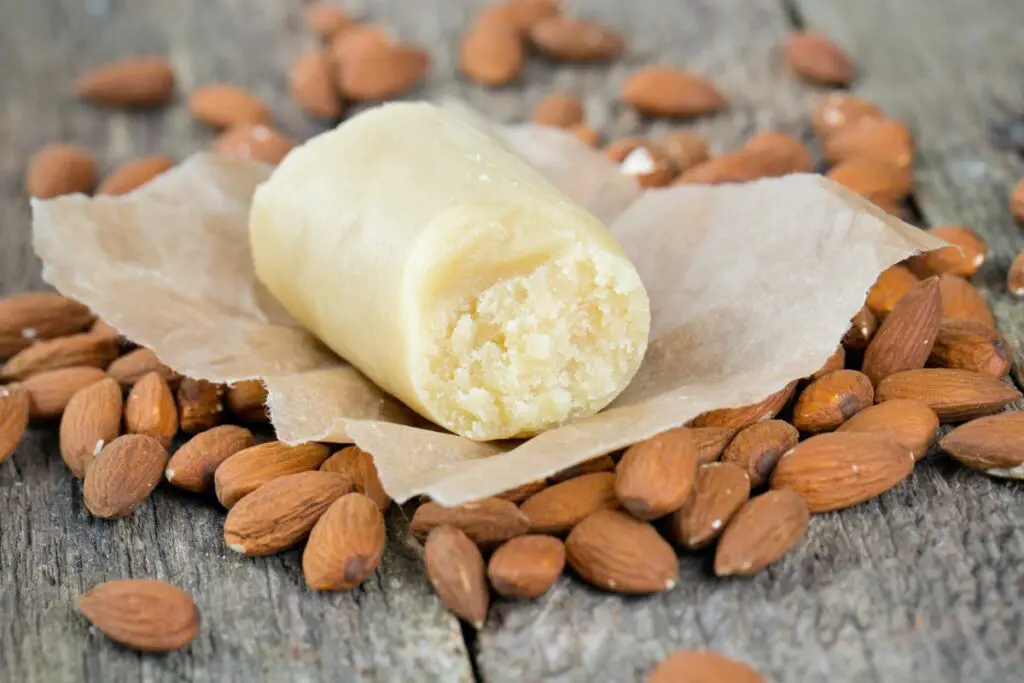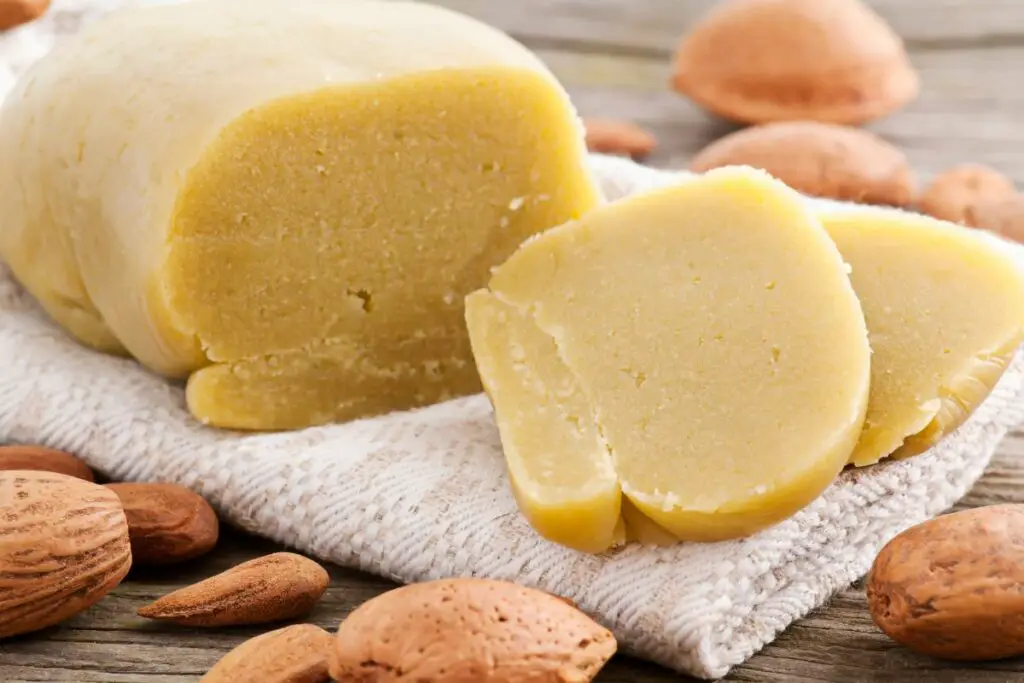Nestled in the realm of confectionery wonders, marzipan stands tall as a delightful treat renowned for its exquisite flavor, smooth texture, and artistic potential.

In this article, we delve into the enticing world of marzipan, uncovering its origins, composition, and even a recipe so you can try and make it yourself.
Whether you are a seasoned marzipan aficionado or a curious novice, join us as we celebrate the artistry and flavors of this marvelous confection!
What Exactly Is Marzipan?
Marzipan is a sweet confectionery made primarily from ground almonds and sugar. It is known for its smooth texture, distinct almond flavor, and versatility as an ingredient in various culinary creations.
The combination of finely ground almonds and sugar creates a pliable paste that can be molded, shaped, and used as a decorative element in desserts, pastries, and cakes.
The almond-sugar mixture is kneaded together to form a smooth, pliable dough. This dough can be shaped into various forms.
Marzipan is often tinted with food coloring to achieve vibrant hues for artistic purposes.
In addition to being enjoyed on its own or as a decorative element, marzipan is also used as a filling for pastries, like the famous Danish pastry called “kringle” or the German Christmas specialty known as “stollen.”
It can also be rolled out and used to cover cakes, providing a smooth and sweet layer beneath the icing.
The History Of Marzipan
The history of marzipan can be traced back centuries, with its origins intertwined in the Middle East and Mediterranean regions.
While the exact details are somewhat elusive, historical records and culinary traditions provide valuable insights into the development and spread of this beloved confection.
Marzipan is believed to have originated in Persia (modern-day Iran) during the Middle Ages. The combination of almonds and sugar, two ingredients abundant in the region, likely led to the creation of an early form of marzipan.
Its popularity quickly spread throughout the Arab world, where it became a staple in the royal courts and among the wealthy elite.
During the medieval period, the Arab confectioners perfected the art of marzipan-making, elevating it to new heights of culinary excellence.
They developed intricate techniques to shape marzipan into elaborate decorative pieces, often featuring fruits, flowers, and animals. Marzipan became a symbol of wealth, luxury, and indulgence.
As trade routes expanded, marzipan made its way into Europe. The Crusaders are often credited with introducing marzipan to the Western world during the 11th and 12th centuries.
They encountered marzipan during their travels in the Middle East and brought back the confection as a cherished souvenir.
In Europe, marzipan found favor among the nobility and aristocracy. It became particularly popular in Italy and Spain, where it was embraced by royalty and incorporated into lavish feasts and celebrations.
In Spain, the city of Toledo became renowned for its marzipan production, and to this day, it remains a center of marzipan craftsmanship.
During the Renaissance, marzipan became an art form in itself. Skilled artisans created intricate marzipan sculptures that adorned tables at banquets and special events.
These edible masterpieces showcased the ingenuity and creativity of the bakers and confectioners of the time.
Throughout the centuries, marzipan continued to evolve and adapt to various cultural traditions and culinary preferences.
Different regions developed their own unique variations and uses for marzipan. In Germany, for example, marzipan is closely associated with Christmas and is used to create marzipan-filled chocolates and holiday treats like “Marzipankartoffeln” (marzipan potatoes).
The rich history of marzipan serves as a testament to its enduring appeal and status as a cherished culinary delight.
How To Make Marzipan

Making marzipan at home is a delightful and rewarding process. With a few simple ingredients, you can create your own batch of this sweet and nutty confection.
Here’s a basic recipe to guide you through the process.
Ingredients
- 2 cups (200g) finely ground almonds or almond flour
- 2 cups (240g) powdered sugar
- 1 teaspoon almond extract
- 1-2 tablespoons rosewater or water (optional, for adjusting consistency)
- Food coloring (optional, for tinting)
Instructions
In a mixing bowl, combine the finely ground almonds or almond flour with the powdered sugar. Stir them together until they are well mixed.
Add the almond extract to the dry mixture and incorporate it thoroughly. The almond extract will enhance the flavor of the marzipan, giving it a pronounced almond taste.
Gradually add a small amount of rosewater or water to the mixture while stirring continuously. This liquid helps bind the ingredients together and achieve the desired consistency.
Add the liquid gradually to avoid making the marzipan too sticky or wet. The goal is to create a pliable dough.
Continue mixing and kneading the mixture until it forms a smooth, homogeneous dough. If the dough feels too dry, add a few more drops of rosewater or water. If the dough becomes too sticky, add a bit more powdered sugar.
At this stage, you can choose to tint your marzipan with food coloring, if desired. Add a few drops of food coloring and knead the dough until the color is evenly distributed.
You can experiment with different shades or divide the dough into smaller portions to create a variety of colors.
Once your marzipan is well mixed and colored (if applicable), wrap it tightly in plastic wrap or place it in an airtight container to prevent drying out.
Allow it to rest for at least 24 hours at room temperature. This resting period helps the flavors meld together and the texture to become more pliable.
Your homemade marzipan is now ready to be used in various confections! Store any unused marzipan in an airtight container in the refrigerator for up to two weeks.
Final Thoughts
Marzipan stands as a timeless testament to the artistry and innovation of confectionery craftsmanship.
From its mysterious origins in the Middle East to its journey across continents and centuries, marzipan has captivated hearts and palates with its delicate balance of almonds and sugar.
Whether enjoyed as a standalone treat, used as an artistic medium, or incorporated into traditional delicacies, marzipan remains a beloved staple in the world of sweets!
- How To Make Honey Butter - July 4, 2023
- How To Make Meringue - July 3, 2023
- What Is Shortening? - July 3, 2023








